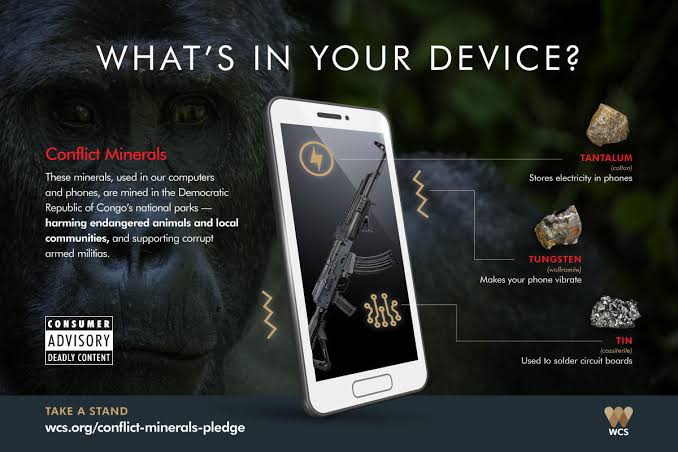Most people would not stand the ill-treatment of children, yet by owning a smartphone, we are at risk of contributing to the escalation of child labour cases in Africa. According to a recent article by the BBC, a typical smartphone contains 0.034gm of gold, 0.34gm silver and 0.015gm palladium, among many other minerals like aluminium (25gm) and copper(15gm). Most mobile phone users share the idea that their devices consist of minerals however, the specific consistency of the said precious metals, is unbeknownst to them. Majority are still unsure about the role these precious metals play and if they are as important as we deem them to be, of what value do they have to end users? This report seeks to answer the highlighted concerns in depth, and with simplicity
Which Minerals Are in Your Phone?
To better understand the minerals used in the smartphone, we shall categorize the three segments of smartphones as follows: the display section, electronics and circuitry and the battery
- The display glass screen is made up of silica mixed with plastic materials and together hardened by potassium. To enable a transparent circuit in the glass screen, Tin, which comes from the main ore cassiterite, is used. To ensure that your phone is always lighting, Gallium mineral is the source of the light-emitting diode for all smartphones. Indium mineral is responsible for ensuring that the display screen is sensitive to touch
- Electronics and Circuitry is largely dependent on conductivity (the ease at which an electric current flows in material). Copper takes the lion’s share in all electronics circuitry due to its excellent conductivity property. Silver seconds copper in providing an electrical pathway to smart phones, while Tantalum ( which comes from Tantalite ore) is responsible for the manufacturing of capacitors, which control voltage and audio quality. Tungsten joins the list as the vibration enabler to all smartphones duto its high density factor
- The Battery is made from Lithium mineral. This is the main component and forms the cathode end of the phone battery coupled with cobalt, a mineral that prevents battery overheating due to its high thermal stability and high energy density. Bastnaesite, another rare mineral and magnetic source found in the battery, can be traced in speakers, microphones and vibrating motors
The 3TGS Conflict Minerals in your Gadget
Of all minerals that make up your smartphone, four main minerals make it to the top of the conflict minerals chart. This is because their mining process is encumbered with political conflicts and armed militia groups involvement, child exploitation, insecurity and other human rights abuses. These four minerals are Tin, Tungsten, Tantalum and Gold (3T and G). Fairphone, one of the smartphone manufacturers, dared to address these vices while finding appropriate supply chains for her raw materials. This came at a time when most smartphone manufacturers were shying away from publishing the source of their minerals, in order to protect their reputation. Amnesty International, a global human rights activism platform cites the Democratic Republic of Congo as the world’s largest producer of cobalt (over 50%), and a darling to giant luxury tech manufacturers. Unfortunately, 40,000 child miners are also found in the mineral-rich zones of Southern DRC
Electronic Waste Could be the Next Disaster
In a recent article exploring the rising consumer behaviour in smartphones, people dump their old smartphones in the trash, while others, either for sentimental purposes or otherwise, choose to hold on to them a little longer. Due to the nature of mineral components found in smartphones, this electronic waste (e-waste) proves hazardous to posterity in so many ways. Take for instance, lithium. When left unchecked in the environment, the mineral affects the body’s nervous system. Nickel and Cadmium, also elements in portable computer batteries, are responsible for soil poisoning when disposed as waste. Steve Manning, the CEO of cell phone giant Reseller Recellular said: “One cell phone in the trash isn’t a big deal. 100 million in the trash is an environmental disaster.”
Possible alternatives: Phone recycling
Did you know that one million mobile phones could deliver nearly 16 tonnes of copper, 350kg of silver, 34kg of gold and 15kg of palladium? Studies show that depleting mineral reserves in the globe annually, is pushing large-scale electronic manufacturers to deep-sea mining which has not been proven as a sustainable or environmentally sound alternative. Apple has set the pace to ensure that all its upcoming gadgets can be disassembled, the minerals removed with ease and eventually smelted back to reusable minerals to make new phones. This process employs the use of the daisy intelligent machine, a tool that removes crucial minerals in the phone’s vibrating elements (Tungsten), battery (Lithium and Cobalt), speakers and circuitry systems. These components find their way to recyclers. Phone recycling is a smart way to stop mining and concentrate on the available old electronics
We should therefore take smartphones seriously. Knowing that these pocket-sized gadgets contain precious minerals and could harm the environment, we should avoid our frequency of buying new phones or any electronic gadgets, at the persuasion of marketing campaigns or sheer boredom with old yet working machines. Together we can make our life worth living with smartphones







10 comments
yjht3h
fkqywo
de176f
150yvj
paumdm
Excellent write-up
0fluqb
qavuo2
h0dfbh
gxiwbr